Automatic Trajectory Determination in Automated Robotic Welding Considering Weld Joint Symmetry
Abstract
:1. Introduction
2. Materials and Methods
2.1. Experimental Set-Up
2.2. Data Acquisition Chain
3. Results
3.1. Processing of Scanned Profiles
- (a)
- The profile is set to 0 (signal acquired in Figure 6a);
- (b)
- The intensity signal acquired by the profilometer is filtered using a phase 0 filter based on a moving median filter. Soft filtering of the signal to eliminate brightness in the profile, with an order N = 7 (see Figure 6b);
- (c)
- The area furthest away from the position sensor (Figure 6c) is calculated using a threshold. This will be defined in further detail in the next section.
3.2. Determination of the Welding Point WP
3.3. Symmetry Analysis
3.4. Automatic Trajectory Determination
4. Conclusions
- A welding cell has been enabled where both robot position, welding parameters, and the geometry of the joint acquired by the laser profilometer have been monitored;
- A simple pre-processing of the profiles extracted from the profilometric laser measurement has been carried out. Six discrete profiles have been selected for each of the faces to be welded. The front side and the back side of the joint. This treatment eliminates aberrant spots due to surface impurities or shiny spots;
- The welding point has been selected based on the analysis of the curve under the profile to be welded. Finally, the calculation has been refined by using a threshold to better define the center point of the joint;
- To determine the angle of attack of the welding arc, a study of the joint symmetry as a function of the rotation of the profile was carried out. An offset close to 0 degrees on the front side and around 3 degrees on the back side has been defined;
- The joint shows symmetry close to pure symmetry, close to the theoretical model of the joint to be welded, with a C coefficient value greater than 0.998. An excessively low value of the symmetry value would mean a failure in the reading, either due to bad acquisition or bad assembly of the joint.
Author Contributions
Funding
Institutional Review Board Statement
Informed Consent Statement
Data Availability Statement
Conflicts of Interest
References
- Ye, G.; Guo, J.; Sun, Z.; Li, C.; Zhong, S. Weld bead recognition using laser vision with model-based classification. Robot Comput. Integr. Manuf. 2018, 52, 9–16. [Google Scholar] [CrossRef]
- Sreeraj, P.; Kannan, T.; Maji, S. Prediction and control of weld bead geometry in gas metal arc welding process using genetic algorithm. Int. J. Mech. Prod. Eng. Res. Dev. 2013, 3, 143–154. [Google Scholar]
- He, Y.; Chen, Y.; Xu, Y.; Huang, Y.; Chen, S. Autonomous detection of weld seam profiles via a model of saliency-based visual attention for robotic arc welding. J. Intell. Robot. Syst. 2015, 81, 4–8. [Google Scholar] [CrossRef]
- Zhang, Z.F.; Yu, H.W.; Lv, N.; Chen, S.B. Real-time defect detection in pulsed GTAW of Al alloys trough online spectroscopy. J. Mater. Process. Technol. 2013, 212, 1145–1156. [Google Scholar]
- Lv, N.; Xu, Y.I.; Zhang, Z.F.; Wang, J.F.; Chen, B.; Chem, S.B. Audio sensing and modeling of and arc dynamic characteristic during pulsed al alloy GTAW process. Sens. Rev. 2013, 33, 141–156. [Google Scholar] [CrossRef]
- Yan, S.J.; Ong, S.K.; Nee, A.Y.C. Optimal pass planning for robotic welding of large-dimension joints with deep grooves. In Proceedings of the 9th International Conference on Digital Enterprise Technology (DET2016)—Intelligent Manufacturing in the Knowledge Economy Era, Nanjing, China, 29–31 March 2016. [Google Scholar]
- Chen, C.L.; Hu, S.S.; He, D.L.; Shen, J.Q. An approach to the path planning of tube–sphere intersection welds with the robot dedicated to J-groove joints. Robot. Comput. Integr. Manuf. 2013, 29, 41–48. [Google Scholar] [CrossRef]
- Tsai, M.J.; Lin, S.D.; Chen, M.C. Mathematical model for robotic arc-welding off-line programming system. Int. J. Comput. Integr. Manuf. 1992, 5, 300–309. [Google Scholar] [CrossRef]
- Shi, L.; Tian, X.C. Automation of main pipe-rotating welding scheme for intersecting pipes. Int. J. Adv. Manuf. Technol. 2015, 77, 955–964. [Google Scholar] [CrossRef]
- Shi, L.; Tian, X.C.; Zhang, C.H. Automatic programming for industrial robot to weld intersecting pipes. Int. J. Adv. Manuf. Technol. 2015, 81, 2099–2107. [Google Scholar] [CrossRef]
- Yang, C.D.; Ye, Z.; Chen, Y.X.; Zhong, J.Y.; Chen, S.B. Multi-pass path planning for thick plate by DSAW based on vision sensor. Sens. Rev. 2014, 34, 416–423. [Google Scholar] [CrossRef]
- Ahmed, S.M.; Yuan, J.Q.; Wu, Y.; Chew, C.M.; Pang, C.K. Collision-free path planning for multi-pass robotic welding. In Proceedings of the 2015 IEEE 20th Conference on Emerging Technologies and Factory Automation, Luxembourg, 8–11 September 2015. [Google Scholar]
- Xiong, J.; Zhang, K. Monitoring Multiple Geometrical Dimensions in WAAM Based on a Multi-Channel Monocular Visual Sensor. Measurement 2022, 204, 112097. [Google Scholar] [CrossRef]
- Ding, D.; He, F.; Yuan, L.; Pan, Z.; Wang, L.; Ros, M. The first step towards intelligent wire arc additive manufacturing: An automatic bead modelling system using machine learning through industrial information integration. J. Ind. Inf. Integr. 2021, 23, 100218. [Google Scholar] [CrossRef]
- Karmuhilan, M.; Sood, A.K. Intelligent process model for bead geometry prediction in WAAM. Mater. Today Proc. 2018, 5, 24005–24013. [Google Scholar] [CrossRef]
- Venkatarao, K. The use of teaching-learning based optimization technique for optimizing weld bead geometry as well as power consumption in additive manufacturing. J. Clean. Prod. 2021, 279, 123891. [Google Scholar] [CrossRef]
- Artaza, T.; Suárez, A.; Veiga, F.; Braceras, I.; Tabernero, I.; Larrañaga, O.; Lamikiz, A. Wire Arc Additive Manufacturing Ti6Al4V Aeronautical Parts Using Plasma Arc Welding: Analysis of Heat-Treatment Processes in Different Atmospheres. J. Mater. Res. Technol. 2020, 9, 15454–15466. [Google Scholar] [CrossRef]
- Wang, C.; Bai, H.; Ren, C.; Fang, X.; Lu, B. A Comprehensive Prediction Model of Bead Geometry in Wire and Arc Additive Manufacturing. J. Phys. Conf. Ser. 2020, 1624, 022018. [Google Scholar] [CrossRef]
- Tang, S.; Guilan Wang, C.H.; Zhang, H. Investigation and control of weld bead ar both ends in WAAM. In Proceedings of the 30th Annual InternationalSolid Freeform Fabrication Symposium and Additive Manufacturing Conference, Austin, TX, USA, 12–14 August 2019. [Google Scholar]
- Li, F.; Chen, S.; Shi, J.; Zhao, Y.; Tian, H. Thermoelectric Cooling-Aided Bead Geometry Regulation in Wire and Arc-Based Additive Manufacturing of Thin-Walled Structures. Appl. Sci. 2018, 8, 207. [Google Scholar] [CrossRef]
- Sarathchandra, D.; Davidson, M.J.; Visvanathan, G. Parameters effect on SS304 beads deposited by wire arc additive manufacturing. Mater. Manuf. Process. 2020, 35, 852–858. [Google Scholar] [CrossRef]
- Dinovitzer, M.; Chen, X.; Laliberte, J.; Huang, X.; Frei, H. Effect of wire and arc additive manufacturing (WAAM) process parameters on bead geometry and microstructure. Addit. Manuf. 2019, 26, 138–146. [Google Scholar] [CrossRef]
- Veiga, F.; Suarez, A.; Aldalur, E.; Artaza, T. Wire Arc Additive Manufacturing of Invar Parts: Bead Geometry and Melt Pool Monitoring. Measurement 2022, 189, 110452. [Google Scholar] [CrossRef]
- Veiga, F.; Suárez, A.; Aldalur, E.; Bhujangrao, T. Effect of the Metal Transfer Mode on the Symmetry of Bead Geometry in WAAM Aluminum. Symmetry 2021, 13, 1245. [Google Scholar] [CrossRef]
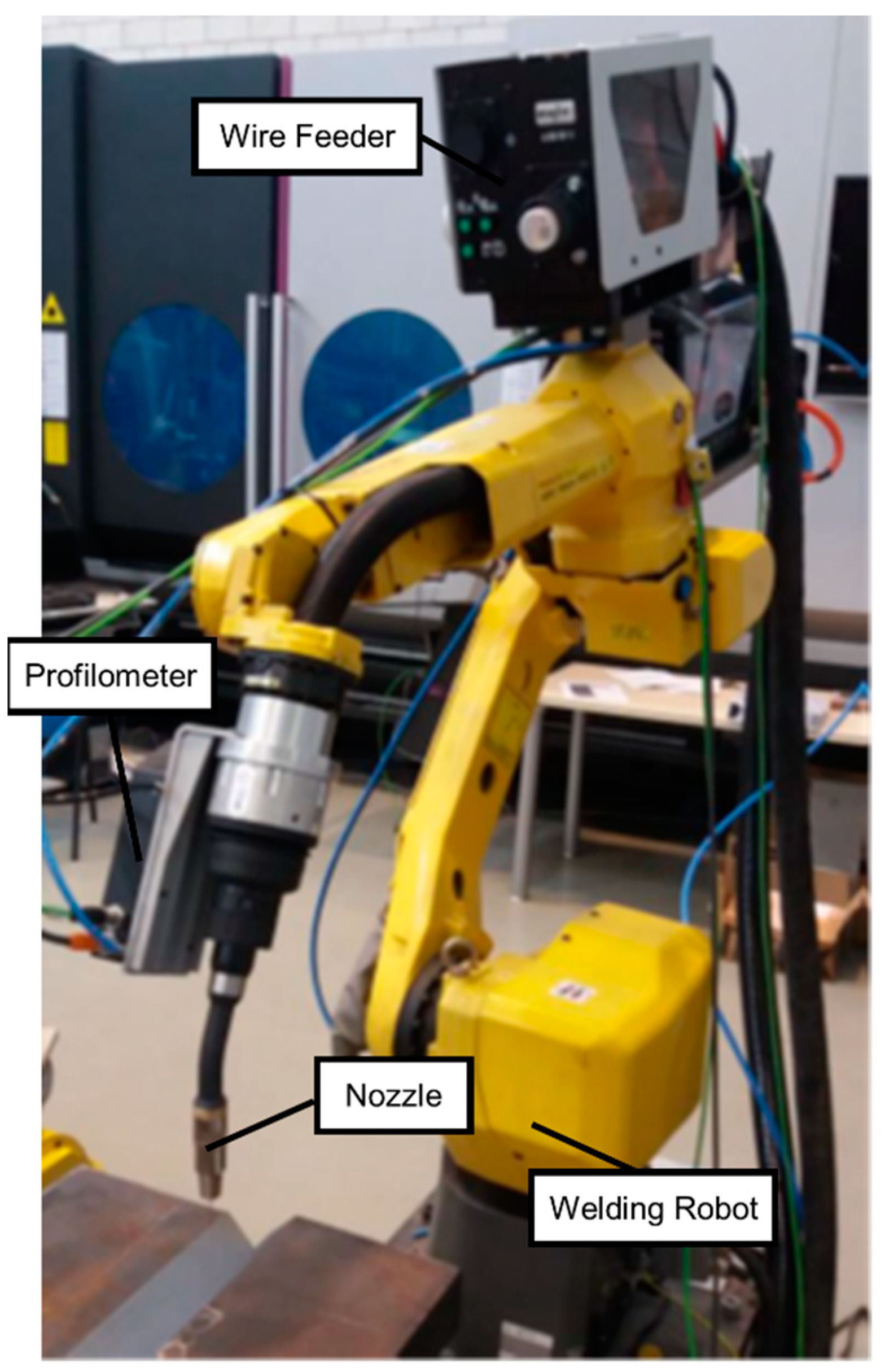
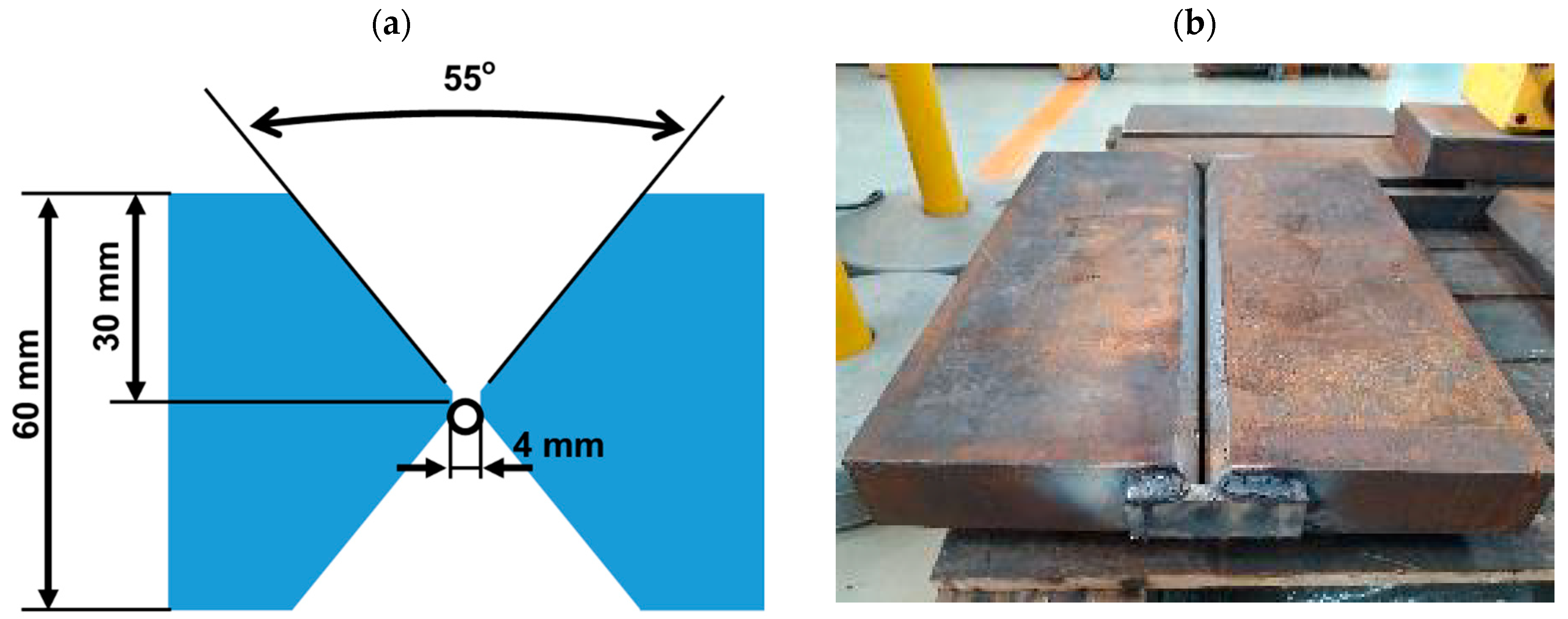

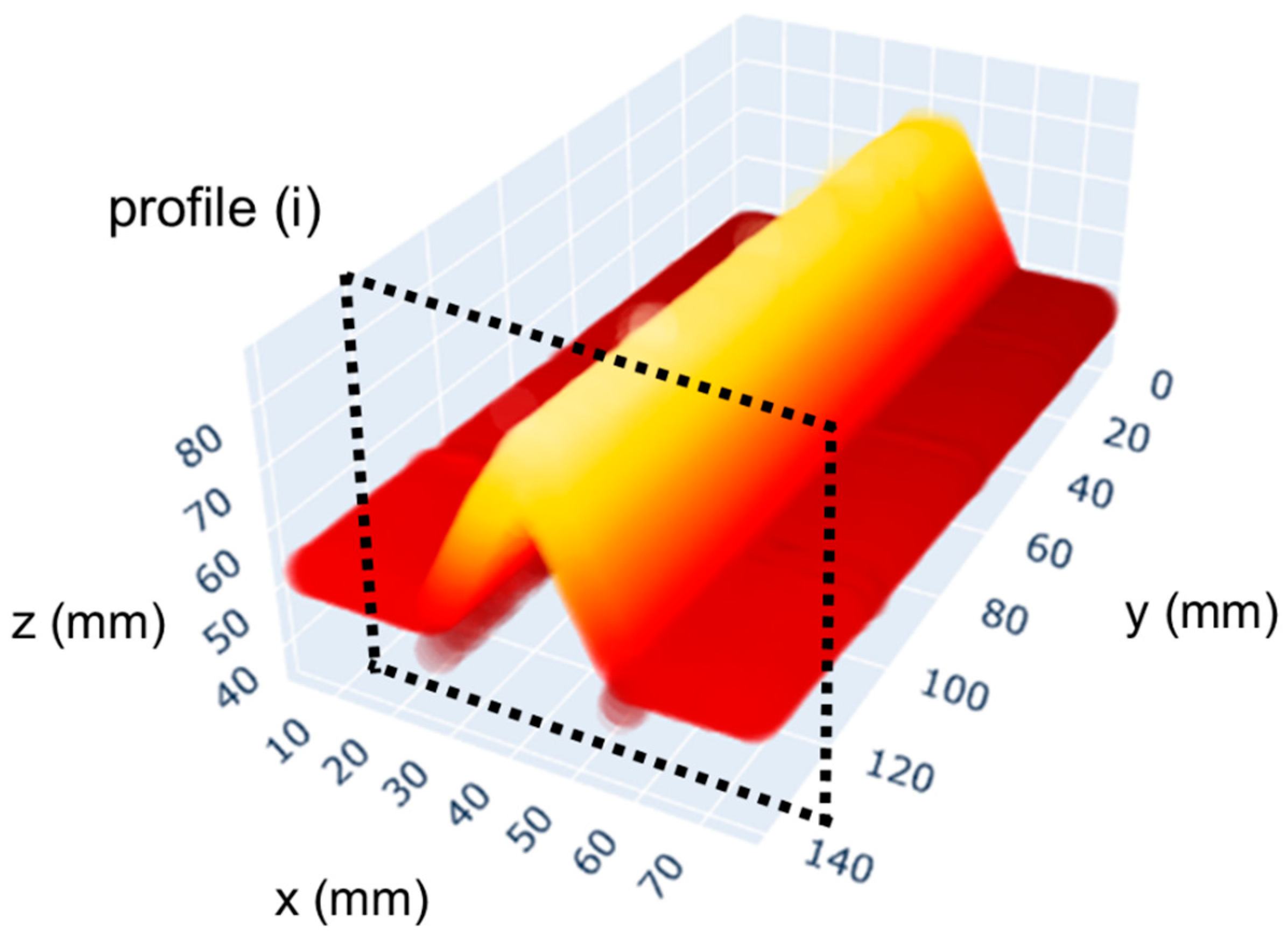


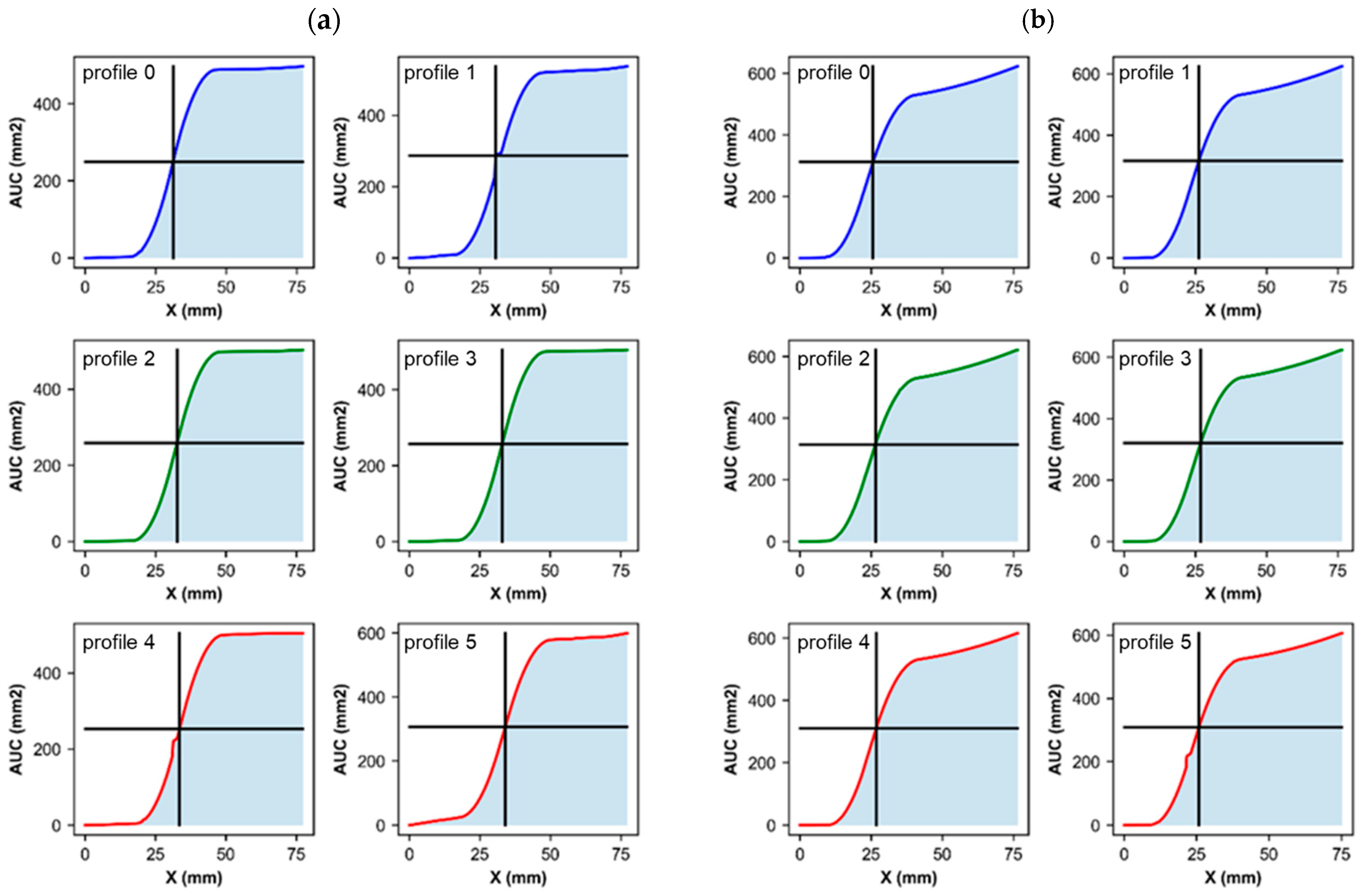


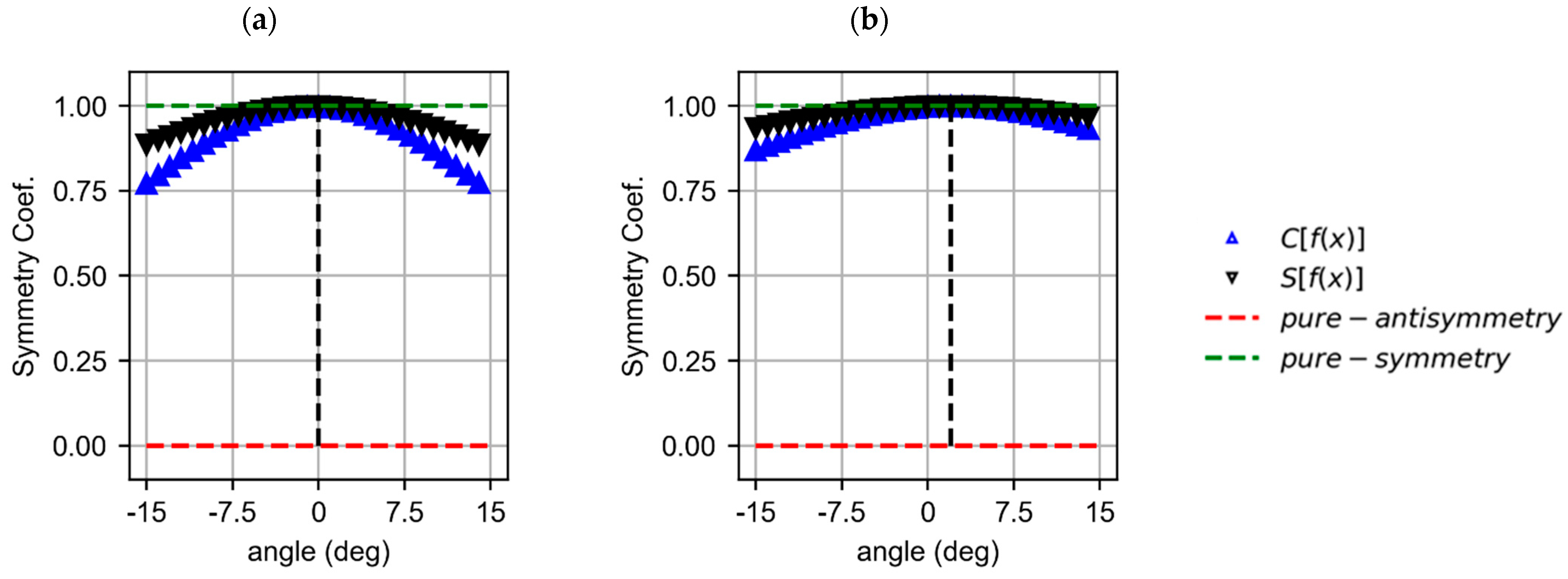
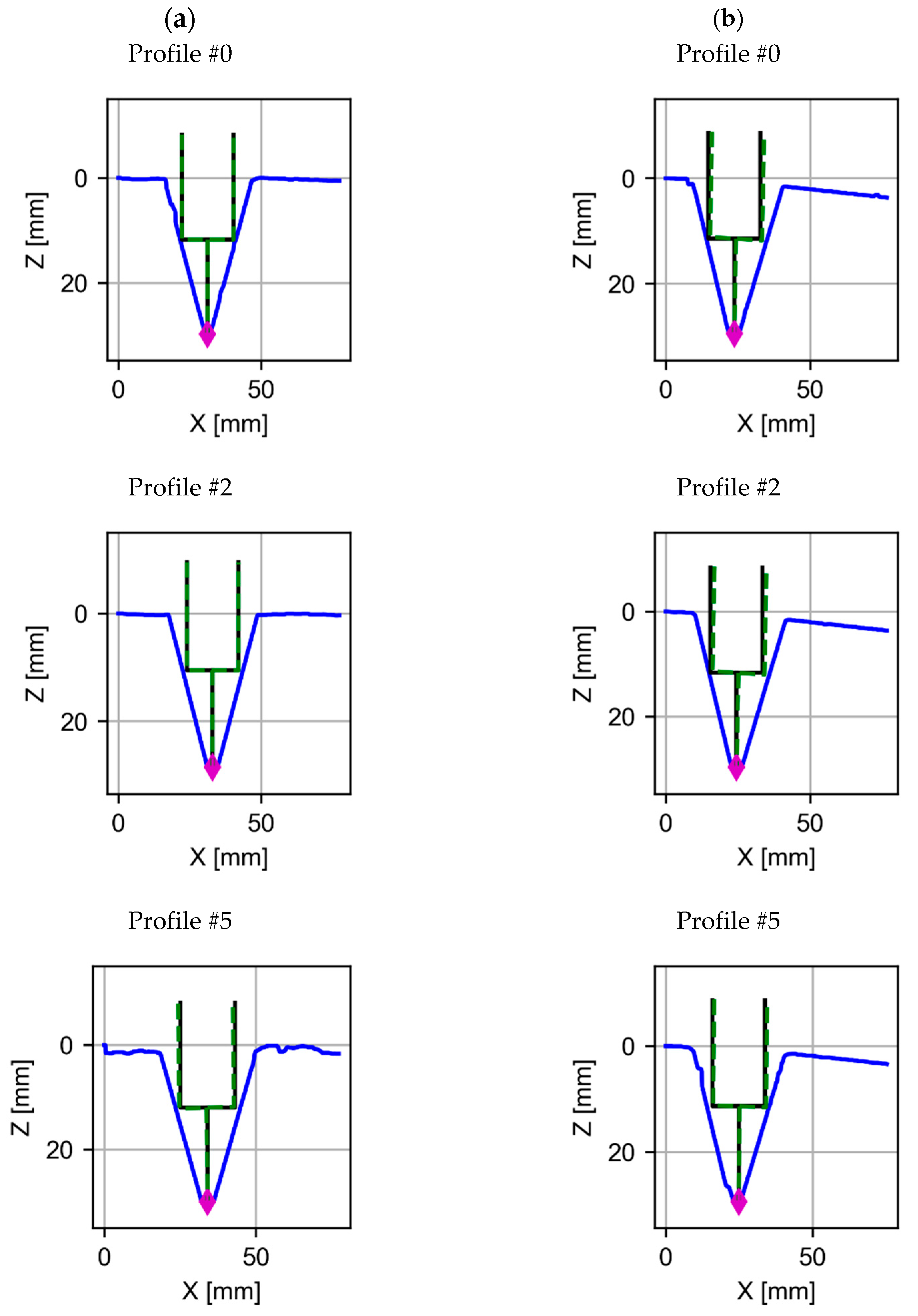
| Z-Range [mm] | X-Range [mm] | Distance [mm] | Resolution [mm] | Start Range X | End Range X | Dimensions [mm] | Weight [g] |
|---|---|---|---|---|---|---|---|
| 120 | 70 | 84 | 0.0798 | 60 | 80 | 186 × 32 × 84 | 430 |
| Nozzle Diameter (mm) | Stick-Out (mm) | Traverse Speed (cm/min) | Wire Feed (cm/min) | Voltage (V) | Current (A) |
|---|---|---|---|---|---|
| 18 | 18 | 42 | 920 | 32 | 280 |
| Joint Side | Coord. xWP | Coord. zWP | C | S | |
|---|---|---|---|---|---|
| Front Joint Profile 0 | 31.182 | 29.766 | 0.9981 | 0.999 | −0.375 |
| Front Joint Profile 1 | 31.738 | 28.799 | 0.9997 | 0.9998 | −0.375 |
| Front Joint Profile 2 | 32.627 | 28.447 | 0.9994 | 0.9997 | −0.375 |
| Front Joint Profile 3 | 32.949 | 28.506 | 0.9983 | 0.9991 | −0.375 |
| Front Joint Profile 4 | 33.848 | 28.564 | 0.9987 | 0.9994 | −0.375 |
| Front Joint Profile 5 | 33.984 | 30 | 0.9992 | 0.9996 | −1.125 |
| Back Joint Profile 0 | 23.672 | 29.473 | 0.9991 | 0.9996 | 2.25 |
| Back Joint Profile 1 | 23.945 | 29.678 | 0.9995 | 0.9998 | 2.625 |
| Back Joint Profile 2 | 24.648 | 28.799 | 0.9982 | 0.9991 | 1.875 |
| Back Joint Profile 3 | 24.521 | 29.678 | 0.9995 | 0.9998 | 2.625 |
| Back Joint Profile 4 | 24.795 | 29.443 | 0.99865 | 0.9993 | 3 |
| Back Joint Profile 5 | 24.805 | 29.385 | 0.99647 | 0.9982 | 1.125 |
Disclaimer/Publisher’s Note: The statements, opinions and data contained in all publications are solely those of the individual author(s) and contributor(s) and not of MDPI and/or the editor(s). MDPI and/or the editor(s) disclaim responsibility for any injury to people or property resulting from any ideas, methods, instructions or products referred to in the content. |
© 2023 by the authors. Licensee MDPI, Basel, Switzerland. This article is an open access article distributed under the terms and conditions of the Creative Commons Attribution (CC BY) license (https://creativecommons.org/licenses/by/4.0/).
Share and Cite
Curiel, D.; Veiga, F.; Suarez, A.; Villanueva, P.; Aldalur, E. Automatic Trajectory Determination in Automated Robotic Welding Considering Weld Joint Symmetry. Symmetry 2023, 15, 1776. https://doi.org/10.3390/sym15091776
Curiel D, Veiga F, Suarez A, Villanueva P, Aldalur E. Automatic Trajectory Determination in Automated Robotic Welding Considering Weld Joint Symmetry. Symmetry. 2023; 15(9):1776. https://doi.org/10.3390/sym15091776
Chicago/Turabian StyleCuriel, David, Fernando Veiga, Alfredo Suarez, Pedro Villanueva, and Eider Aldalur. 2023. "Automatic Trajectory Determination in Automated Robotic Welding Considering Weld Joint Symmetry" Symmetry 15, no. 9: 1776. https://doi.org/10.3390/sym15091776






